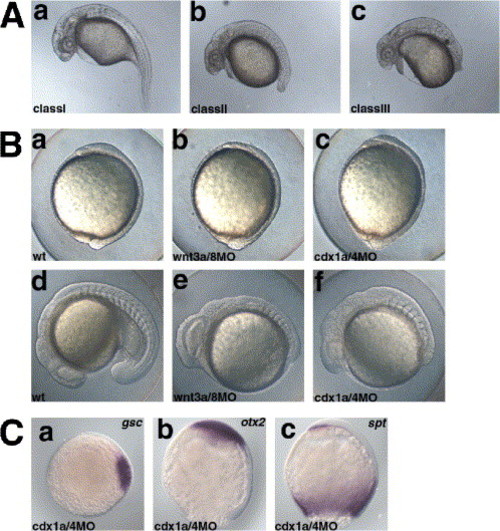Fig. 4
- ID
- ZDB-FIG-050510-13
- Publication
- Shimizu et al., 2005 - Interaction of Wnt and caudal-related genes in zebrafish posterior body formation
- Other Figures
- All Figure Page
- Back to All Figure Page
|
Cooperation of Cdx1a and Cdx4 in formation of the posterior body. (A) Phenotypes of cdx1aMO and/or cdx4MO-injected pharyngula-stage (24 hpf) embryos. The phenotypes were classified into three categories. In Class I embryos, the tail was extended but its size was reduced, and the number of somites was not changed (30?34 somites). Class II embryos had a truncated tail structure (number of the somites 20?30, average 25.2 (n = 10)). Class III embryos had no evident structure protruding from the yolk (no tail structure; less than twenty somites, average 10.3 (n = 12)). The percentage of embryos in each class is shown in Table 2. (B) Comparison between the wnt3a/wnt8 and cdx1a/cdx4 morphant embryos. The phenotypes of wild-type (non-injected) control embryos (wt, a, d), embryos receiving an injection of 4.2 ng of wnt3aMO and wnt8MOs (wnt3a/8MO, b, e), and embryos receiving an injection of 2.1 ng of cdx1aMO and cdx4MO (cdx1a/4MO, cdx1a/cdx4 morphant embryos, c, f), at the bud stage (a?c, lateral views with dorsal to the right) and 17 hpf (d?f, lateral views, with anterior to the left). Neither the wnt3a/wnt8 nor the cdx1a/cdx4 morphant embryos showed strong morphological abnormalities at the bud stage. At 17 hpf (17-somite stage for the wild-type), both the wnt3a/wnt8 and cdx1a/cdx4 morphant embryos displayed a truncated tail, whereas only the wnt3a/wnt8 morphant embryos had an enlarged head and eyes. (C) Expression of goosecoid (gsc) (a) at the shield stage, and otx2 (b) and spadetail (spt) (c) at the 90% epiboly stages in the cdx1a/cdx4 morphant embryos. Expression of these genes was not significantly affected in the cdx1a/cdx4 morphant embryos, compared with the wild-type embryos (Fig. 1). a, animal pole view with dorsal to the right. b, c lateral views with dorsal to the right. |
| Genes: | |
|---|---|
| Fish: | |
| Knockdown Reagents: | |
| Anatomical Terms: | |
| Stage Range: | Shield to 90%-epiboly |
Reprinted from Developmental Biology, 279(1), Shimizu, T., Bae, Y.K., Muraoka, O., and Hibi, M., Interaction of Wnt and caudal-related genes in zebrafish posterior body formation, 125-141, Copyright (2005) with permission from Elsevier. Full text @ Dev. Biol.

